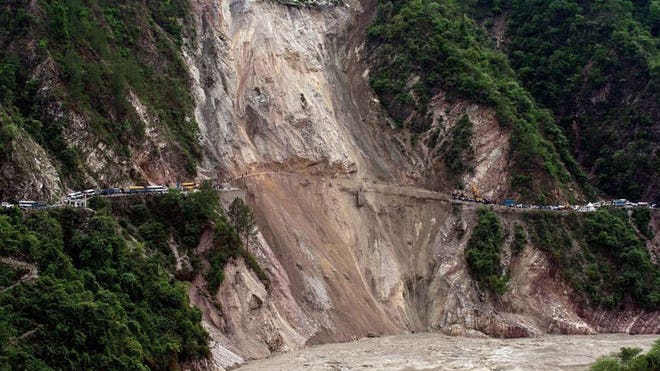 |
| Landslide |
When I was flying to Nepalgunj during my field trip a few weeks ago, I was looking out my airplane window and all I could see was hills and hills of forests. I know that deforestation is one of Nepal’s largest problems but it seemed to me that there was so much forest,how could it be such a problem? But as I looked a little closer, I began to see it: small areas around villages were missing areas of trees. Much clearer to me was some of the secondary effects of deforestation in Nepal. Throughout many of the hills, I could see areas where landslides had occurred. As well, many of the crop areas were very dry, and food was struggling to grow in these areas.
 |
| Collecting Wood |
For these reasons, I actually can see the importance of the project I’m working on here, the Multi Stakeholder Forestry Project. The project is working in some of the western hills districts to help communities self-manage their local forests to prevent some of these effects and prevent further effects of climate change. Although the project has just begun this past year, I’m confident that IDS Nepal is going to make a difference in the sustainable management of forests.
*The photos in this post are not my own but representative of some of the effects I've seen.
Darrelle, I was interested to hear your comments about how much forest there still exists in Nepal. I know there has been problems re denudation of the forests for some time, but of course the problem being, this appears to be their only source for heating and cooking. I'm assuming, in the larger cities everyone has alternate fuel sources, but I'm not sure that is accurate. Do people in the cities still use wood? Your discussion was very interesting, and I'm sure that your time is well spent to help these people figure out how to develop & manage trees/forests close to home for the many reasons you have pointed out. Keep up the good work. Aunt tina
ReplyDeleteFor the most part in Kathmandu, people use gas as a source of heat and cooking fuel. However, I'm sure there are some people, particularly around the outskirts of the city, who use wood still. Thanks very much Aunt Tina and I look forward to learning more about the forests in Nepal.
DeleteHi Darrelle
ReplyDeleteI am interested to know what strategies they have introduced to reduce the consumption of wood. Curtis recently went to Guatemala where the local rural population are coping with a similar problem. Organizations, such as the one Curtis is involved with, are introducing "stoves" which have greatly reduced the consumption of wood. A major side benefit is the reduction in respiratory illness because the residents are no longer inhaling smoke from open fires.
From your posts it seems that you are enjoying a very broad exposure to the culture of Nepal. It doesn't sound like you are homesick at all!!! Aunt Jo
I have seen a number of the stoves like you are describing that are able to use the heat more efficiently and that does definitely help. Another initiative that is promoted and my organization has been quite involved in is the production/distribution of bio-briquettes. They're essentially compact discs or bricks of raw material biomass that can be used as an alternative source of fuel. This way they are able to use leftover biomass from agriculture or other production as a source of fuel. In many areas people have started small businesses producing and selling these bio-briquettes.
DeleteI'm definitely enjoying a broad exposure to Nepal's culture and enjoying learning about the country. Thanks so much Aunt Jo!